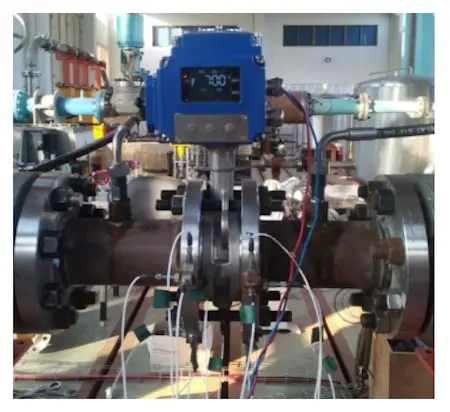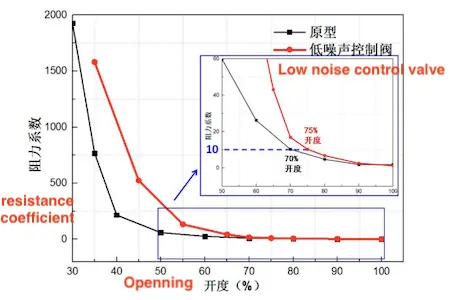Research on Low Noise of Butterfly Valves (Part Two)
Jun 02, 2024
3. Vibration and Noise Characteristics Test of Butterfly Valves
3.1 Test systems and working conditions
The hydraulic and acoustic characteristics of the two regulating butterfly valves were tested on a low-background-noise pipeline test platform, as shown in Figure 4. By comparing the vibration and noise characteristics of the two valves under the same hydraulic conditions, the effectiveness of the low-noise structural design is verified. Since the regulating butterfly valve is generally not used at lower openings, the test angle starts from 35% open. The test conditions are shown in Table 1. Install a differential pressure transmitter at the inlet and outlet of the valve to test the pressure drop generated by the flow through the valve. The vibration acceleration measurement points are arranged according to the absolute coordinate system. The six measurement points are located at the inlet and outlet of flanges, middle part and lower part of the valve body. One acceleration sensor is placed at each measurement point in the x (pipeline direction), y (horizontal direction), and z (valve stem direction) axes, with a total of 18 vibration acceleration sensors. A hydrophone is installed at both the inlet and outlet of the valve to measure the flow noise.

Figure 4 Valve tests of DN80
Table 1 Test conditions of valves
3.1 Test systems and working conditions
The hydraulic and acoustic characteristics of the two regulating butterfly valves were tested on a low-background-noise pipeline test platform, as shown in Figure 4. By comparing the vibration and noise characteristics of the two valves under the same hydraulic conditions, the effectiveness of the low-noise structural design is verified. Since the regulating butterfly valve is generally not used at lower openings, the test angle starts from 35% open. The test conditions are shown in Table 1. Install a differential pressure transmitter at the inlet and outlet of the valve to test the pressure drop generated by the flow through the valve. The vibration acceleration measurement points are arranged according to the absolute coordinate system. The six measurement points are located at the inlet and outlet of flanges, middle part and lower part of the valve body. One acceleration sensor is placed at each measurement point in the x (pipeline direction), y (horizontal direction), and z (valve stem direction) axes, with a total of 18 vibration acceleration sensors. A hydrophone is installed at both the inlet and outlet of the valve to measure the flow noise.

Figure 4 Valve tests of DN80
Table 1 Test conditions of valves
| Types | Original Butterfly Valve/Improved Butterfly Valves |
| Opening working conditions (%) | 35, 40, 50, 60, 70, 80, 90, 100 |
3.2 Comparison of hydraulic characteristics of valves
The hydraulic characteristics of the two DN80 valves are illustrated in Figure 5. The results show that after low-noise optimization, the resistance characteristics of the two valves are almost the same for openings greater than 60%. Only for openings less than 50% does the resistance of the low-noise valve increase, but compared to the original valve, the increase is small. The hydraulic state of the original valve at 70% open and the low-noise control valve at 75% open are consistent, with both having a resistance coefficient of 10.

Figure 5 Resistance coefficient of two DN80 valves at different openings
3.3 Comparison of valve vibration characteristics before and after improved design
When the resistance coefficient of the two valves is 10, the total vibration acceleration levels in three directions in the 10Hz-10kHz frequency band are shown in Table 2. The test results show that the vibration acceleration of the low-noise control valve has been significantly reduced, with the root mean square vibration acceleration in the three directions reduced by 13 dB, 13 dB, and 10 dB, respectively. This shows that the low-noise optimization design, involving the installation of layered baffles, can reduce the vibration level of the valve body through reasonable rectification without significantly affecting the hydraulic characteristics or increasing the valve resistance.
Table 2 Valve body vibration acceleration of two DN80 valves with the same resistance coefficient
| Items | X direction (dB) | Y direction (dB) | Z direction (dB) |
| Original butterfly valves | 137 | 125 | 125 |
| Improved butterfly valves | 124 | 112 | 115 |
| Decrease by | 13 | 13 | 10 |
3.4 Comparison of flow noise characteristics before and after improved design
The inlet and outlet flow noise spectra of the two valves with a resistance coefficient of 10 are shown in Figure 6. The inlet and outlet flow noise of the two valves in the 10Hz-2kHz frequency band is shown in Table 3. The test results show that the design structure of the low-noise control valve has a significant noise reduction effect, reducing flow noise levels at the inlet and outlet by 8 dB and 9 dB, respectively.
Table 3 Vibration acceleration of the two valves of DN100 with the same resistance coefficient
| Items | Inlets (dB) | Outlets (dB) |
| The original butterfly valve | 185 | 187 |
| The improved butterfly valve | 176 | 178 |
| Increased by | 9 | 9 |

Figure 6 Inlet and outlet flow noise spectrum of DN80 valves
4. Conclusion
The general flow rules of the flow field in the butterfly valve are explored by calculating the flow field. Based on this, the geometric form of the valve plate is optimized. The flow field characteristics before and after optimization are compared, and experimental tests are conducted. Analysis of calculation and test results leads to the following conclusions:
(1) Through the flow or pressure drop test results at different openings, the resistance coefficient of the valve was obtained using the partial resistance element formula. The butterfly valves before and after optimization can achieve the same resistance coefficient at different openings.
(2) Under the same hydraulic conditions, the vibration and noise levels of the butterfly valve have been significantly reduced after optimization. The vibration acceleration of the valve body has been reduced by 10 to 13 dB (10 Hz to 10 kHz), and the inlet and outlet flow noise has been reduced by 8 to 9 dB (10 Hz to 2 kHz). This result verifies the effectiveness of the layered guide comb structure in reducing vibration and noise.
Previous: Ceramic Valves for Liquid Chlorine Filling & High and Negative Pressure
Next: Applications of Ceramic Valves in Carbide Slurry & Solid Particles



